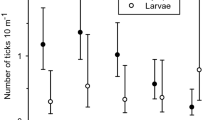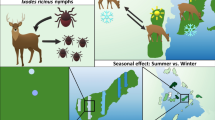Abstract
Ticks were sampled by flagging, collecting from the investigator's clothing (walking samples), trapping with dry-ice bait, and collecting from mammal hosts on Fire Island, NY, U.S.A. The habitat distribution of adult deer ticks,Ixodes dammini, was the same in simultaneous collections from the investigator's clothing and from muslin flags. Walking and flagging samples can both be biased by differences between investigators, so the same person should do comparative samples whenever possible. Walking samples probably give a more accurate estimate than flagging samples of the human risk of encountering ticks. However, ticks (such as immatureI. dammini) that seek hosts in leaf litter and ground-level vegetation are poorly sampled by walking collections. These ticks can be sampled by flagging at ground level.
Dry-ice-baited tick-traps caught far more lone-star ticks,Amblyomma americanum, than deer ticks, even in areas where deer ticks predominated in flagging samples. In comparisons of tick mobility in the lab, nymphalA. americanum were more mobile than nymphalI. dammini in 84% of the trials. Therefore, the trapping bias may result from increased trap encounter due to more rapid movement byA. americanum, although greater attraction to carbon dioxide may also play a role. Tick traps are useful for intraspecific between-habitat comparisons.
Early in their seasonal activity period, larvalI. dammini were better represented in collections from mouse hosts than in flagging samples. Apparently, sampling from favored hosts can detect ticks at low population levels, but often cannot be used to get accurate estimates of pathogen prevalence in questing ticks.
Similar content being viewed by others
References
Anderson, J. and Magnarelli, L.A., 1980. Vertebrate host relationships and distribution of ixodid ticks (Acari: Ixodidae) in Connecticut, US. J. Med. Entomol., 17:314–323.
Anderson, J.F. and Magnarelli, L.A., 1984. Avian and mammalian hosts for spirochete-infected ticks and insects in a Lyme disease focus in Connecticut. Yale J. Biol. Med. 57: 627–641.
Art., H.W., 1976. Ecological Studies of the Sunken Forest, Fire Island National Seashore, New York. Nat. Park Serv., Sci. Monogr. Ser., No. 7, 237 pp.
Bosler, E.M., Coleman, J.L., Benach, J.L., Massey, D.A., Hanrahan, J.P., Burgdorfer, W. and Barbour, A.G., 1983. Natural distribution of theIxodes dammini spirochete. Science, 220: 321–323.
Bosler, E.M., Ormiston, B.G., Coleman, J.L., Hanrahan, J.P. and Benach, J.L., 1984. Prevalence of the Lyme disease spirochete in populations of white-tailed deer and white-footed mice. Yale J. Biol. Med. 57: 651–659.
Calhoun, J.B., 1951. North American Census of Small Mammals. National Institute of Mental Health, NACSM Annu. Rep., 12 pp.
Carey, A.B., Krinsky, W.L. and Main, A.J., 1980.Ixodes dammini (Acari: Ixodidae) and associated ixodid ticks in south-central Connecticut, USA. J. Med. Entomol., 17: 89–99.
Carey, M.G., Carey, A.B., Main, A.J., Krinsky, W.L. and Sprance H.E., 1981.Ixodes dammini (Acari: Ixodidae) in forests in Connecticut. J. Med. Entomol., 18: 175–176.
Clymer, B.C., Howell, D.C. and Hair, J.A., 1970. Environmental alteration in recreational areas by mechanical and chemical treatment as a means of lone star tick control. J. Econ. Entomol., 63: 504–509.
Garris, G.I., Stacey, B.R., Hair, J.A. and McNew, R.W., 1979. A comparison of lone star ticks on Brahman and Hereford cattle. J. Econ. Entomol., 72: 869–872.
Ginsberg, H.S. and Ewing, C.P., 1989. Habitat distribution ofIxodes dammini (Acari: Ixodidae) and Lyme disease spirochetes on Fire Island, NY. J. Med. Entomol., 26: 183–189.
Gray, J.S., 1985. A carbon dioxide trap for prolonged sampling ofIxodes ricinus L. populations. Exp. Appl. Acarol., 1: 35–44.
Main, A.J., Sprance, H.E., Kloter, K.O. and Brown, S.E., 1981.Ixodes dammini (Acari: Ixodidae) on white-tailed deer (Odocoileus virginianus) in Connecticut. J. Med. Entomol., 18: 487–492.
Main, A.J., Carey, A.B., Carey, M.G. and Goodwin, R.H., 1982. ImmatureIxodes dammini (Acari: Ixodidae) on small mammals in Connecticut, USA. J. Med. Entomol., 19: 655–664.
Patrick, C.D. and Hair, J.A., 1977. Seasonal abundance of lone star ticks on white-tailed deer. Environ. Entomol., 6: 263–269.
Piesman, J. and Spielman, A., 1979. Host associations and seasonal abundance of immatureIxodes dammini in southeastern Massachusetts. Ann. Entomol. Soc. Am., 72: 829–832.
Piesman, J., Donahue, J.G., Mather, T.N. and Spielman, A., 1986. Transovarially acquired Lyme disease spirochetes (Borrelia burgdorferi) in field-collected larvalIxodes dammini (Acari: Ixodidae). J. Med. Entomol., 23: 219.
Schulze, T.L., Bowen, G.S., Bosler, E.M., Lakat, M.F., Parkin, W.E., Parkin, W.E., Altman, R., Ormiston, B.G. and Shisler, J.K., 1984.Amblyomma americanum: a potential vector of Lyme disease in New Jersey. Science, 224: 601–603.
Schulze, T.L., Bowen, G.S., Lakat, M.F., Parkin, W.E. and Shisler, J.K., 1986. Seasonal abundance and hosts ofIxodes dammini (Acari: Ixodidae) and other ixodid ticks from an endemic Lyme disease focus in New Jersey USA. J. Med. Entomol., 23: 105–109.
Semtner, P.J. and Hair, J.A., 1973. The ecology and behavior of the lone star tick (Acari: Ixodidae). V. Abundance and seasonal distribution in different habitat types. J. Med. Entomol., 10: 618–628.
Spielman, A., Wilson, M.L., Levine, J.E. and Piesman, J., 1985. Ecology ofIxodes dammini borne human babesiosis and Lyme disease. Annu. Rev. Entomol., 30: 439–460.
Stalter, R., Lamont, E.E. and Northup, J., 1986. Vegetation of Fire Island, New York. Bull. Torrey Bot. Club, 113: 298–306.
Strickland, R.K., Gerrisch, R.R., Hourrigan, J.L. and Schubert, G.O., 1976. Ticks of Veterinary Importance. USDA Agric. Handb no. 485, 122 pp.
Waladde, S.M. and Rice, M.J., 1982. The sensory basis of tick feeding behaviour. In: F.D. Obenchain and R. Galun (Editors), Physiology of Ticks. Pergamon Press, Oxford, pp. 43–70.
Wallis, R.C., Brown, S.E., Kloter, K.O. and Main, A.J., 1978. Erythema chronicum migrans and Lyme arthritis: Field study of ticks. Am. J. Epidemiol., 108: 322–327.
Wilson, J.G., Kinzer, D.R., Sauer, J.R. and Hair, J.A., 1972. Chemo-attraction in the lone star tick (Acarina: Ixodidae). I. Response of different developmental stages to carbon dioxide administered via traps. J. Med. Entomol., 9: 245–252.
Author information
Authors and Affiliations
Rights and permissions
About this article
Cite this article
Ginsberg, H.S., Ewing, C.P. Comparison of flagging, walking, trapping, and collecting from hosts as sampling methods for northern deer ticks,Ixodes dammini, and lone-star ticks,Amblyomma americanum (Acari: Ixodidae). Exp Appl Acarol 7, 313–322 (1989). https://doi.org/10.1007/BF01197925
Accepted:
Issue Date:
DOI: https://doi.org/10.1007/BF01197925




